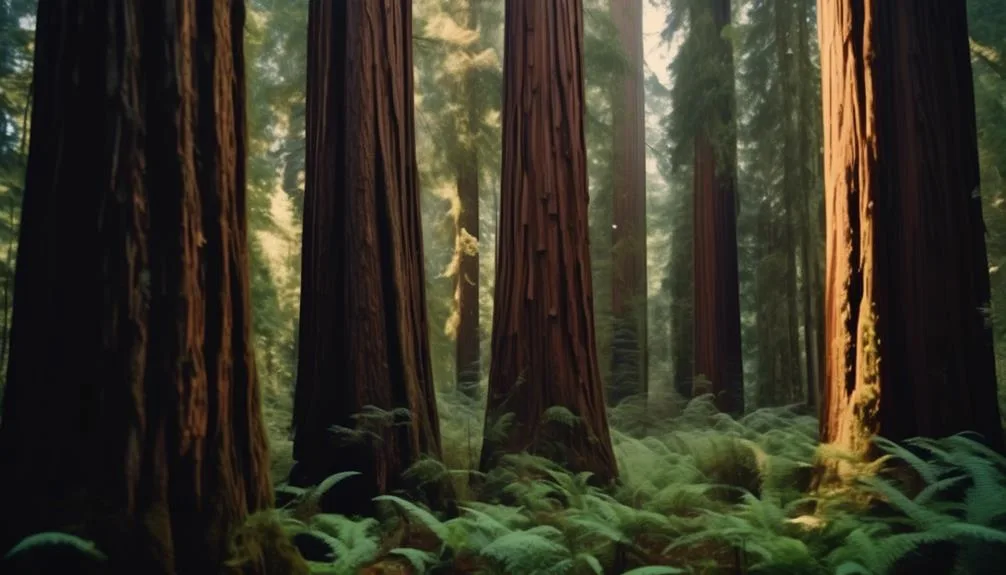Standing among the towering redwood trees, it's clear they hold a vital role in fighting climate change. These ancient giants are exceptional at capturing and storing carbon dioxide, playing a crucial part in reducing greenhouse gas levels.
But what makes them so effective at this? Let's explore the world of redwood forests and their impact on our planet's carbon balance.
Redwood Trees and Carbon Sequestration
Redwood trees play a crucial role in sequestering carbon from the atmosphere, helping to mitigate the impacts of climate change. These giants can grow to be over 350 feet tall, and their rapid growth rate means they capture more carbon than most other trees.
Their thick, spongy bark and high tannin content also make them incredibly resistant to pests and diseases, allowing them to live for thousands of years and continue sequestering carbon throughout their long lives. Redwoods have the ability to capture and store substantial amounts of carbon dioxide through the process of photosynthesis, in which they convert carbon dioxide into oxygen and carbon-based compounds.
This makes them invaluable in the fight against climate change, as their impressive carbon capture capacity helps to offset human carbon emissions.
Efficiency of Redwood Trees in Carbon Storage
With their towering height and dense, spongy bark, redwood trees efficiently capture and store substantial amounts of carbon dioxide, contributing significantly to the mitigation of climate change. Redwood trees are renowned for their exceptional carbon sequestration efficiency.
Their rapid growth patterns, coupled with their ability to live for thousands of years, make them highly effective at storing carbon. The sheer size of these trees allows them to sequester large quantities of carbon, with some redwoods holding more than 2,600 tons of carbon in their massive trunks alone.
Additionally, their extensive root systems and the dense forest floors they create further enhance their carbon storage capacity. These remarkable attributes make redwood trees a crucial component in the fight against climate change, underscoring their importance in global carbon sequestration efforts.
Redwood Forests and Climate Change Mitigation
How can the vast expanse of redwood forests contribute to the global efforts in mitigating climate change? Redwood forests play a crucial role in climate change mitigation through their exceptional capacity for carbon capture. By preserving these forests, we can significantly reduce the amount of carbon dioxide in the atmosphere, thereby combating climate change. The redwood ecosystem, with its towering trees and dense foliage, acts as a massive carbon sink, absorbing and storing substantial amounts of carbon. To illustrate their impact, consider the following table:
| Redwood Forest Benefits | Description |
|---|---|
| Carbon Capture | Absorbs and stores carbon |
| Climate Regulation | Influences local climate |
| Biodiversity Preservation | Supports diverse wildlife |
Preserving redwood forests is an essential strategy for climate change mitigation, as it enhances carbon sequestration, regulates local climate, and supports biodiversity.
Impact of Redwood Trees on Atmospheric Carbon
When exploring the impact of redwood trees on atmospheric carbon, one may wonder about the mechanisms that enable these majestic giants to store significant amounts of carbon dioxide. Redwood trees play a crucial role in carbon sequestration through their remarkable tree growth patterns, which contribute to their ability to store vast amounts of carbon.
Here's how they do it:
- Rapid Vertical Growth:
- Redwood trees are among the fastest-growing trees, reaching heights of over 300 feet in their quest for sunlight and space.
- This rapid vertical growth leads to substantial carbon sequestration as the trees continuously absorb and store carbon throughout their lifespan.
- Long Lifespan:
- Redwoods can live for thousands of years, enabling them to accumulate and store significant amounts of carbon over their lifetime.
Redwood Trees and Global Carbon Balance
Redwood trees play a pivotal role in maintaining the global carbon balance by sequestering substantial amounts of carbon dioxide through their rapid growth and long lifespan.
Furthermore, their impact extends to soil health and ecosystem services. The fallen leaves, branches, and roots of redwood trees enrich the soil with organic matter, enhancing its structure and fertility. This, in turn, promotes the growth of diverse plant species and contributes to the overall health of the ecosystem.
Redwood trees also provide essential ecosystem services, such as regulating water flow, preventing erosion, and supporting diverse wildlife.
Their immense contribution to carbon sequestration, soil health, and ecosystem services makes redwood trees indispensable in maintaining the delicate balance of carbon in the global environment.
Conclusion
As we wander through redwood forests, let's recognize the vital role these majestic trees play in capturing and storing carbon.
Their impact on global carbon balance is significant, making them crucial allies in combating climate change.
Considering their efficient carbon sequestration, redwood trees stand as essential guardians against rising carbon levels and their impact on our planet.
Mark Hoffman is a dedicated arborist and tree care specialist with over a decade of experience. His love for trees began when he visited Yosemite National Park as a teenager and was awestruck by the giant sequoias. Mark pursued his passion by studying forestry at Michigan Technological University, where he earned a Bachelor of Science degree.
Since then, he has worked tirelessly in the field of arboriculture, helping to preserve and protect trees in his community. His expertise and dedication have made him a respected leader in the industry and a valuable resource for anyone seeking advice on tree care.
